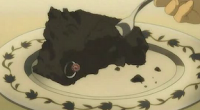 With the on-going Potter mania and my recent reviews of Book 6 and Book 7 respectively, I guess it won't feel right if I skipped the review of the movie - 5th in the heptalogy
With the on-going Potter mania and my recent reviews of Book 6 and Book 7 respectively, I guess it won't feel right if I skipped the review of the movie - 5th in the heptalogy 
I watched this last Wed (cheap movie night  ) with Peen, and though the effects were good, I felt as if everything was in fast-forwarded motion in order to cramped the underlying plot into a 2 hour 15 minutes show. One moment, we were at Privet Drive with appearance of Dementors, and next we were at Grimmauld Place (HQ for the Order), then back to Hogwarts where Umbridge took over as headmistress, DA (short for Dumbledore's Army) formed secretly to learn Defence against the Dark Arts, Harry-Cho's kiss (rather forgettable if you ask me), Harry's visions through the connection to Voldemort's mind, Occlumency lessons with Snape as well as Thestrals, a giant and centaurs thrown in along the way ...yup, we sorta "jumped" from one scene to the other, like snapshots taken randomly from the book
) with Peen, and though the effects were good, I felt as if everything was in fast-forwarded motion in order to cramped the underlying plot into a 2 hour 15 minutes show. One moment, we were at Privet Drive with appearance of Dementors, and next we were at Grimmauld Place (HQ for the Order), then back to Hogwarts where Umbridge took over as headmistress, DA (short for Dumbledore's Army) formed secretly to learn Defence against the Dark Arts, Harry-Cho's kiss (rather forgettable if you ask me), Harry's visions through the connection to Voldemort's mind, Occlumency lessons with Snape as well as Thestrals, a giant and centaurs thrown in along the way ...yup, we sorta "jumped" from one scene to the other, like snapshots taken randomly from the book .
.
Before you know it, we had arrived at the Ministry of Magic. This was the highlight of the movie as finally the speed slowed down just nice, and we learned about the prophecy between Harry & Voldemort ("either must die by the hand of the other, for neither can live while the other survive",) arrival of Death Eaters bend on snatching the glowing crystal ball that contained the prophecy (notably Lucius Malfoy and Bellatrix Lestrange), a fierce battle ensued with awesome effects put to good use (shelves of prophecies collapsing, curses in the form of colored lights flying everywhere,) and we thought all was lost as Harry's friends were captured in the Death Chamber and Lucius threatened to kill them unless Harry handed the crystal ball over. Our hearts leaped with joy when Sirius (Harry's Godfather) and other members of the Order arrived to save the day (or night) and battle continued. Just when we thought victory was within grasp (Harry stunned a Death Eater while Sirius knocked Lucius into a wall) Bellatrix appeared and "Avada Kedavra", the killing curse, hit Sirius who fell into an archway in the middle of the chamber, disappearing forever...
See what I mean when I said fast-forwarded mode with perfect pace, enjoyable & exciting mode?? If you had not read the book before watching the show, or if you had not been following Harry Potter since the very beginning, this movie will most likely cause scratching of heads, raising of eyebrows, questions marks or worse, heavy eyelids (seriously, one of my colleague experienced that.) Of course there are people who enjoyed the show just as much, with some even experiencing near "heart-attack" moments (you know who you are LOL.) For 6 bucks, yeah, I guess it's worth it..
(Oh, and "disappearing forever" is not the end just yet. To find out what happened, read the book or watch the movie LOL. I recommend both to get the best of both worlds - complete events & detailed descriptions with the former, great audio visuals with the latter  )
)
My rating: 

 (compared to the book)
(compared to the book)






















 3) "Bathing machines, " windowless huts which were wheeled into the sea, allowed one to change in privacy and enter immediately into the water, to conform to Victorian standards of modesty. The bathing machines are identical rental units, differentiated by numbers on the top of the entrance.
3) "Bathing machines, " windowless huts which were wheeled into the sea, allowed one to change in privacy and enter immediately into the water, to conform to Victorian standards of modesty. The bathing machines are identical rental units, differentiated by numbers on the top of the entrance. 

 5) England's aristocrats resented the "pavernu," people who suddenly came into great wealth due to the industrial revolution, as these "upstarts" began showing up at their social functions. The Jones family were "upstarts" which was why they wanted the union of the Jones & Campbell family so much to finally have the one thing they most craved - acceptance. Viscount Campbell clearly was not keen on the union but only agreed as it would definitely solved the financial issues the family was facing.
5) England's aristocrats resented the "pavernu," people who suddenly came into great wealth due to the industrial revolution, as these "upstarts" began showing up at their social functions. The Jones family were "upstarts" which was why they wanted the union of the Jones & Campbell family so much to finally have the one thing they most craved - acceptance. Viscount Campbell clearly was not keen on the union but only agreed as it would definitely solved the financial issues the family was facing. 




















